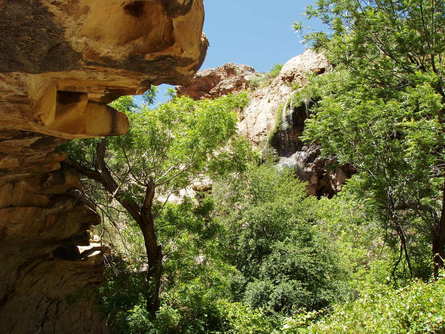At the head of a short canyon in the desert is a place with trees and other lush vegetation. Water falls in rivulets down a broad, mounded wall of built-up travertine (smooth rock laid down from limestone dissolved in the waters) that is on one side of the canyon head, and collects in a broad pool below. The pool at the waterfall base overflows into multiple tiny streams that tumble and interconnect through a series of small pools to join a flowing stream undercutting the opposite canyon wall, leading out beyond the oasis. Between the splitting and rejoining streamlets are small islands shaded by the low trees.
Dimensions The oasis area is about 100 feet (35 m) across, and the enclosing walls rise about 40 feet (12 m). The layout map shows cliffs (black comb-pattern lines), water (dark grey), and trees (light outlines) on a five-foot (.5 m) square grid.
Key Details

- The water running down the falls is spring-fed from a location not far above, so it is fairly constant in flow through dry periods. The water gushes much more actively following cloudbursts, but due to small area of drainage above the falls, the stronger flow does not flood over the oasis floor, or persist very long.
- Travertine sheets have been deposited by water descending the falls, building up and outward in an overlapping fashion over the centuries. Some air spaces have been enclosed between travertine sheets, to form a small cave with narrow, high, interconnected parallel passages large enough to hold a dozen people. The cave entrance is a slanting crevice below an overhanging travertine layer, at one edge of the falls.
- The pools are clear, rimmed with algae and moss, and host fish and amphibians. Although smaller pools are less than 10 feet across, some are two or more feet deep.
- Bedrock and large blocks of fallen canyon wall mix with soil on the floor of the oasis, providing many places for sunning, and also helping make for uneven or slanting ground on some of the smaller islands. With the active growth of brush and trees, this rough ground limits range of view from most places on the canyon floor. There are many small, private spaces around pools to explore below the tree canopy.
- The stream that exits the oasis is 15 feet across and flowing actively, but diminishes with distance as it travels further out along a dry canyon floor. It disappears as a tired trickle in the storm-sculpted streambed, within half a mile of its source.
Story Elements

- This is a good place to hide out, but also to be ambushed.
- People approaching from parched higher ground will suddenly see a view of lush vegetation opening up below.
- People approaching this spot by walking up-canyon in the dry streambed will see the shallow trickle of water first, and as they move further upstream will be rewarded with more abundant water, and shade of trees in the oasis.
- Within a broad expanse of desert where creatures and people are hard to find, this oasis will be frequently visited. Beyond fish and frogs, it would be reasonable to have an appearance of any region-appropriate creature helpful to the story.
- The cave entrance will be hard to find, and is most likely to be noticed by those with prior knowledge of its existence, or those with considerable leisure time to spend at the oasis.
- Characters might be required to chase something floating or swimming through the maze of streams and pools.
- Characters might need to scrape away at the travertine surface of the falls, to free something partly covered by the deposits. If so, they will be awkwardly standing in the pool, with water splashing down from above.
- A concealed place among the trees and pools might be a blind for an idyll, meeting, badly needed rest and healing, or observation of other visitors to the oasis.
- Varying depths of the different pools and stream sections could surprise someone racing through the tree-covered zone.
- This will be a memorable milestone or goal of a cross-desert journey.
- Combat Dynamics:
- The availability of water and wood in the oasis may be a tactical advantage for a group besieged here.
- A very interesting running fight or larger battle could be set in the pool and island area, with need to leap from one spot to another, various opportunities for concealment, possible hidden threats in trees or pools, and so on.
- Snipers could attack the oasis floor from above, on the rim of the canyon wall. Rock overhangs found some places along the wall base may provide shelter from attack.
Reference Location
Sitting Bull Falls Recreation Area, Lincoln National Forest, southeastern New Mexico. This park area is open in daytime, year-round (vehicle entry fee). Some of the trees at this site were burned by a 2010 range fire. Cave access only by arrangement with site rangers. It is part of the Guadalupe Mountains region, which also hosts the Boulder Canyon, Desert Streambed Throughway, and Decorated High Gallery scenes.
© Rice-Snows 2017
Proudly powered by Weebly





